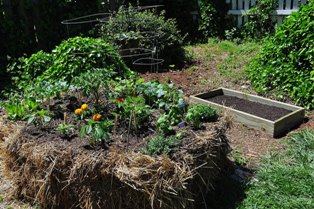With a new hay season around the corner it’s time to clean out the hay shed and remove spoiled or stale hay in readiness for the new supply. Even with well-kept hay there will always be a certain amount of wastage; there may be anything from a pile of sweepings to several bales that might have been affected by damp and are suitable for cattle to eat, but not horses.
While burning gets rid of this quickly, a hay bonfire is money going up in smoke while adding carbon to the atmosphere, and a valuable resource is being wasted.
There are many ways to recycle and re-use old hay. First and foremost, it is a key compost ingredient and a marvelous mulching material.
Spreading biscuits of old hay around the base of trees, several centimentres away from the trunk, as summer mulch, will reduce the amount of water the tree needs. Water-in the hay once it has been placed.
 |
Smother weed clumps in pasture with a thick layer of hay, robbing them of light and moisture while encouraging the growth of naturally sown grasses from the germinating hay seeds. These are best done in springtime when there will be plenty of rain.
Loose barley straw (NOT hay) thrown into a dam in spring, will produce a chemical as it decomposes, that kills algae.
Whole bales of hay have many uses. Construct a three-sided hay-bale compost bin that will contain the composting materials, add heat to accelerate breakdown. Eventually the ‘walls’ will break down to become more compost.
Layer material such as manure, straw, lawn and garden clippings, branches, newspapers, cardboard, etc inside the hay bale bin and turn once a month to make rich garden compost.
Hay bale walls last for a year or two and make a soft-looking, natural barrier that can be recycled into compost or mulch when they no longer look good.
Set bales end-to-end, brick fashion, to contain a section of garden, create a vegetable patch, or as a shelter for sheep. They also make fantastic forts for children!
In the vegie patch, old lucerne hay makes a wonderful mulch that releases valuable nitrogen while decomposing.
Hay bales make great raised beds in which to grow vegetables. The bed should be constructed and prepared a month or so before use, so any heat in the bale won’t kill the vegetable seedlings.
Build a bed of any preferred size, making sure the hay twine is on the sides so the cut ends of hay are facing up. Soak bales with a mixture of water and organic nitrogen fertiliser, according to directions on the label, and perhaps sprinkle over some blood and bone. Do this every three days for 12 days, then leave as is for a couple of weeks. For a more elaborate garden, close in bales with plastic and top with a layer of soil. To plant seedlings, part the hay with a trowel, pour in a little potting mix and add the chosen seedlings. Water and feed as usual.
Grow potatoes easily in a tower made of old tyres or chicken wire. Layer old manure and old hay or straw in the ‘tower’ and place potatoes among the layers.
A bale garden bed could also be placed near the stable, planted with horse-friendly herbs such as meadowsweet, calendula, comfrey, vervain, and peppermint, to be picked and added to feeds; if allowed to graze directly, the horses will pull the plants out of the hay. Carrots can grow well in straw or hay bales, but lots of bales will be needed to maintain a regular supply for the horses!
If you can’t find a use for hay bales on your own property, donate them to schools, fetes, neighbours or businesses where display is required.



